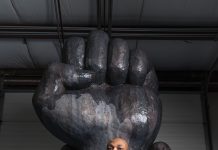
Gisela McDaniel’s journey as an artist started in the second grade with a paintbrush and an imagination. Years later, McDaniel — who was born at a military base in Bellevue, Nebraska, and has Indigenous CHamoru roots from Guam — began painting herself and others professionally as an outlet from sexual trauma she experienced as an adult. She uplifts the stories of others through oil paintings with mixed media and memorabilia. Whether it be a subject’s favorite old piece of jewelry, a childhood toy, or a piece of clothing, McDaniel incorporates their keepsakes into her paintings. This gives viewers the chance to acknowledge the story behind the person in the painting in addition to the painting itself.
The 27-year-old painter is now based in Detroit and represented by London-based gallery Pilar Corrias. Her portraits emphasize Black, Indigenous, and nonbinary people of color. McDaniel is breaking ground not only in Detroit but at both national and international galleries; her work can be found in Los Angeles, Miami, London, and Bangladesh. Earlier this year, McDaniel participated in the Institute of Contemporary Art Boston’s group exhibition A Place for Me: Figurative Painting Now and presented her solo exhibition Manhaga Fu’una at Pilar Corrias. These exhibitions tell the healing stories of Black, brown, and Indigenous women and nonbinary people of color.
Hour Detroit spoke with McDaniel about her art, the stories behind the people she paints (who she refers to as her “subject-collaborators”), and more.

Hour Detroit: Why did you choose painting as an outlet for your and others’ experiences and stories?
Gisela McDaniel: I went through some personal experiences where I was really frustrated. I found this process that was something where I could reclaim my body, celebrate myself, and not feel bad about it. That started with me on a private level just drawing myself. The process had always stayed the same, and the root of it was always what I needed. I realized what was helping me, and I just wanted to share it with other people.
How does your Indigenous CHamoru culture influence your work?
When I’m doing self-portraits, I am thinking more about my movements going on the island [of Guam] and using my own figure to be more of a character to have conversations around that. When I’m doing a bunch of work on paper, I’m thinking about the military buildup or movement [such as the Indigenous youth leadership program Protect Guam Water]. The way I edit audio [from interviews with subjects] is very much like weaving. You’re not going to see me physically weaving in the work, but it’s something ancient CHamorus did and people do today. It’s something I want to honor in my heritage, but it’s not very physical.
Explain the references and details incorporated into your paintings.
A lot of the things on the surface [of the painting] are going to come from subject-collaborators who donated [objects], which is completely optional. I think about wearables, jewelry, and clothes and how worn things have stories as well. You look at an outfit and you might remember an experience you had or look at jewelry and remember who gave it to you or why you bought it for yourself. We’re giving life to maybe a homecoming dress you wore that you’re never going to wear again or something that’s already messed up, and to honor that, that’s life. I’m also painting memorabilia and things people want surrounding them. It’s not necessarily physical objects. It’s almost like an altar built around you — they’re all hints about who you are.
What do you hope people will take away from your art?
I hope that people understand how much of a gift [my art] is and how much intimacy is involved in this practice. There’s a lot of layers to it and I hope people walk away just thinking about the fact that we all carry things and that we should be gentle with each other, we should be caring with each other. I’m blessed to get to learn from you all, hear stories, and I think those are the best lessons when it’s coming from a firsthand experience. It’s not the type of knowledge you learn in school — it’s just real-life shit. That’s such a precious thing to share. I hope some people feel celebrated; I hope some people see themselves and feel beautiful. Whether they’re in the piece or identify with it, I hope everybody else just listens.
Find McDaniel’s works at giselamcdaniel.com.
This story is from the August 2022 issue of Hour Detroit magazine. Read more in our digital edition.
|
|
|









